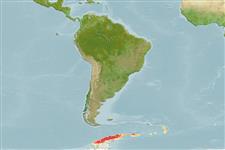Symplectoscyphus nesioticus Blanco, 1977
| Native range | All suitable habitat | Point map | Year 2050 |

|
| This map was computer-generated and has not yet been reviewed. |
| Symplectoscyphus nesioticus AquaMaps Data sources: GBIF OBIS |
Upload your photos
Google image |
No photo available for this species.No drawings available for Sertulariidae.
Google image |
No photo available for this species.
Classification / Names Common names | Synonyms | CoL | ITIS | WoRMS
Hydrozoa | Leptothecata | Sertulariidae
Environment: milieu / climate zone / depth range / distribution range Ecology
Demersal; depth range 90 - 522 m (Ref. 7416). Polar
Distribution Countries | FAO areas | Ecosystems | Occurrences | Introductions
Antarctic Atlantic: South Shetland and Antarctica.
Length at first maturity / Size / Weight / Age
Maturity: Lm ? range ? - ? cm Max length : 1.5 cm H male/unsexed; (Ref. 7416)
Short description Morphology
Tiny stems up to ca 0.5 cm long. Stem internodes long and distinctly arranged in zig-zag fashion. Hydrothecae situated at the end of stem internode. Hydrotheca almost tubular and directed up- and outwards. Hydrotheca free for most of its adcauline wall; free part of adcauline hydrothecal wall straight. Hydrotheca with a distinct inflexion point where adcauline wall becomes free. Abcauline wall straight or slightly abcaudally directed at its distal part. Cusps of hydrothecal aperture sharp and separated by deep embayments. Hydrotheca widening at the aperture.
Found at depths of 90 to 522 m; on Bryozoans and hydroids (Ref. 7416).
Life cycle and mating behavior Maturity | Reproduction | Spawning | Eggs | Fecundity | Larvae
Members of the order Leptothecata include L-form hydroids. Life cycle: The zygote develops into planula and later into polyp then into free-swimming medusa.
Main reference
References | Coordinator | Collaborators
Peña Cantero, A.L., A. Svoboda and W. Vervoort. 2002. (Ref. 7416)
IUCN Red List Status (Ref. 130435)
CITES status (Ref. 108899)
Not Evaluated
CMS (Ref. 116361)
Not Evaluated
Threat to humans
Harmless
Human uses
| FishSource |
Tools
More information
Internet sources
BHL | BOLD Systems | CISTI | DiscoverLife | FAO(Publication : search) | Fishipedia | GenBank (genome, nucleotide) | GloBI | Gomexsi | Google Books | Google Scholar | Google | PubMed | Tree of Life | Wikipedia (Go, Search) | Zoological Record
Estimates based on models
Preferred temperature
(Ref. 115969): -0.9 - 1.1, mean 0.1 (based on 22 cells).


